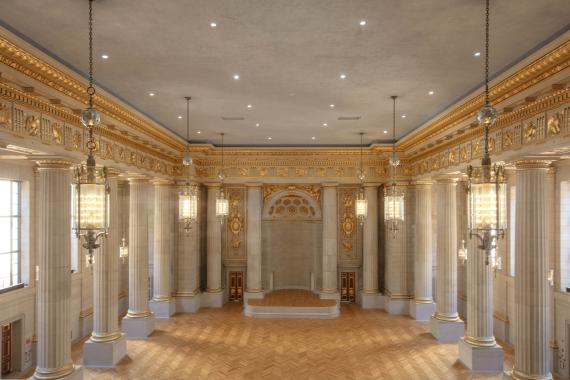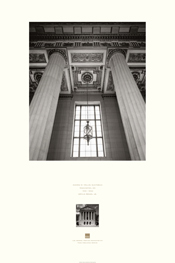Location: 1301 Constitution Ave. NW, Washington, DC 20240
History
Refined Doric details articulate the Andrew W. Mellon Auditorium, the most dramatic example of Classical Revival architecture in the Federal Triangle. The Triangle is a massive complex of government buildings constructed during the 1930s on a site bounded by Pennsylvania and Constitution Avenues between 6th and 15th Streets, NW. The 70-acre project was the largest building program undertaken by the government to that time. The Departmental Auditorium, as it was originally known, is part of a three-building ensemble facing the National Mall.
Plans to redevelop the area between Pennsylvania Avenue and the Mall began to take shape with the 1902 report of what has become known as the McMillan (or Senate Park) Commission. The Commission was a group of four prominent designers appointed by Michigan Senator James McMillan, chairman of the Senate District Committee, to chart the future of Washington’s historic core. Implementation of plans, however, went largely unrealized until Congress appropriated money in 1926 and 1928 for the work.
A team including some of the nation’s most respected architects, known as the Board of Consulting Architects, planned the Federal Triangle buildings. The board considered Classical Revival architecture appropriate for conveying the power and permanence of the national Government. Arthur Brown, Jr., an Ecole des Beaux-Arts-trained architect from San Francisco, became responsible for designing an ensemble to house the Labor Department, the Departmental Auditorium, and the Interstate Commerce Commission.
President Franklin D. Roosevelt dedicated the auditorium on February 25, 1935. Among a number of historic events in the building, President Harry S Truman hosted the 1949 signing of the North Atlantic Treaty, which established the North Atlantic Treaty Organization (NATO).
The building was renamed in 1987 in honor of Andrew W. Mellon, who oversaw the development of the Federal Triangle complex while serving as Secretary of the Treasury from 1921 to 1932. The Mellon Auditorium was listed in the National Register of Historic Places as a component of the Pennsylvania Avenue National Historic Site in 1966.
Architecture
Architect Arthur Brown, Jr., gave the Andrew W. Mellon Auditorium a monumental Doric temple front to serve as the central focus of his three-part building group. Like other buildings in the Federal Triangle, Brown’s trio of buildings is constructed of steel frames clad in Indiana limestone. Red terra-cotta tiles roof the seven-story auditorium building. Colonnades resting on arched portals connect the auditorium to the twin office buildings designed for the Interstate Commerce Commission and the Department of Labor. The three units encompass nearly six acres and extend 1,000 feet along Constitution Avenue.
The Mellon Auditorium faces Constitution Avenue and is entered through three doorways in the deeply channeled Indiana limestone above Deere Island pink granite. Granite stairs rise to the main doors. All three entrance openings stand 20 feet tall and have gates made of gilded and burnished aluminum, topped with spearheads and tassels. Four 10-foot-high bracket lamps of gilded and burnished aluminum, with foliated volutes supporting the lamp and a pineapple finial, frame the entrances.
Six colossal fluted Roman Doric columns rise 62 feet 6 inches above the base to create the auditorium’s portico. The columns are matched by fluted Doric pilasters set against the smooth limestone back wall. This wall has a large niche above which is a historical bas-relief. Flanking the niche are doors providing access to the portico. Crowning the portico, the auditorium’s central pediment displays Edgar Walter’s “Columbia,” a richly carved allegorical sculpture group symbolizing the country, national defense, and national resources.
The grandeur of the building’s exterior is matched by its interior. In the stair hall vestibule, the first major interior space of the auditorium, limestone-finished walls and piers define the room and frame views of even grander spaces beyond, including the east and west staircases and the lobby. The marble floor is laid in rectilinear patterns of gold, pink, and dark red marble. The auditorium’s lobby is similar to the vestibule.
At the heart of the building is the large meeting room, a spectacular auditorium four stories in height that seats 2,500. Fluted Doric columns surround the room, which is embellished with limestone pilasters, gilded relief carvings, and polished oak. The walls and columns consist mostly of acoustical stone, with the lower portions remaining relatively plain, pierced only by doors and vents with ornamental grilles. Colossal luminaries, made of brass and burnished aluminum, are suspended from the ceiling.
GSA modernized the auditorium in 2002-03. The project restored exterior stonework and key interior spaces such as the small meeting room and the east and west committee rooms. In all three of these rooms, located north of the large meeting room, the deep green glaze and gold leaf accents of the wood-paneled walls were re-created as they originally appeared. The building served as the set for several movies and television shows, including “The West Wing.” The modernization project also upgraded office spaces to meet modern technological needs as part of a larger restoration of Federal Triangle buildings to house the U.S. Environmental Protection Agency (EPA).
Significant Events
- 1926: The Public Buildings Act is passed, providing $50 million for Federal construction.
- 1928: The Triangle Bill authorizes acquisition of land in the area that became the Federal Triangle.
- 1931: Construction begins on the Labor Department, Interstate Commerce Commission, and the Departmental Auditorium buildings.
- 1935: Official dedication of the auditorium takes place in February.
- 1949: President Harry S. Truman signs the North Atlantic Treaty in the auditorium, establishing the North Atlantic Treaty Organization (NATO).
- 1966: Mellon Auditorium listed in the National Register of Historic Places.
- 1987: An act of Congress renames the Departmental Auditorium in honor of former Secretary of the Treasury Andrew W. Mellon.
- 2002-2003: Office spaces are modernized by GSA to accommodate new technology and restore key historic interior spaces for the new tenant, the EPA.
- 2023: Restoration of historic finishes completed.
Building Facts
- Architectural Style: Classical Revival
- Architect: Arthur Brown, Jr.
- Construction Dates: 1931-34
- GSA Building Number: DC0523AB
- Landmark Status: A component of the Pennsylvania Avenue National Historic Site
- Primary Materials: Indiana limestone, Deere Island pink granite, structural steel
- Prominent Features: Doric temple front facing Constitution Avenue; 2,500-seat large meeting room
Poster download
Download the poster [PDF - 108 KB]

 U.S. General Services Administration
U.S. General Services Administration

